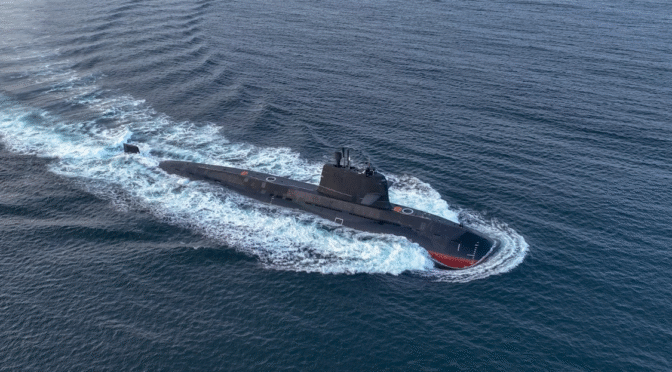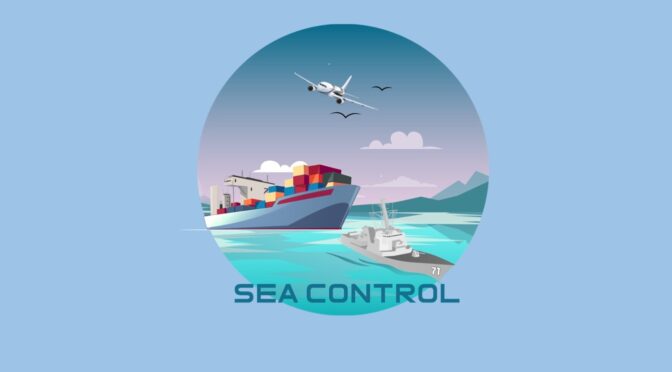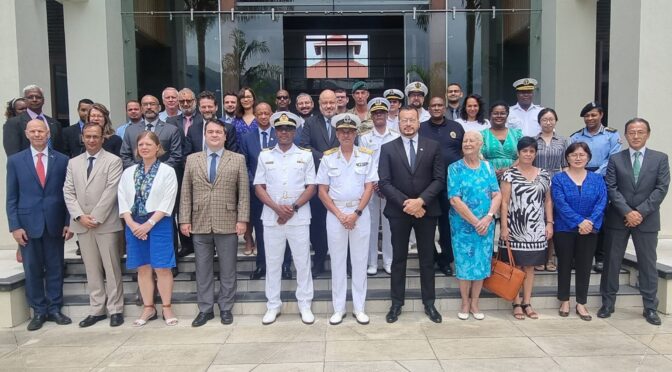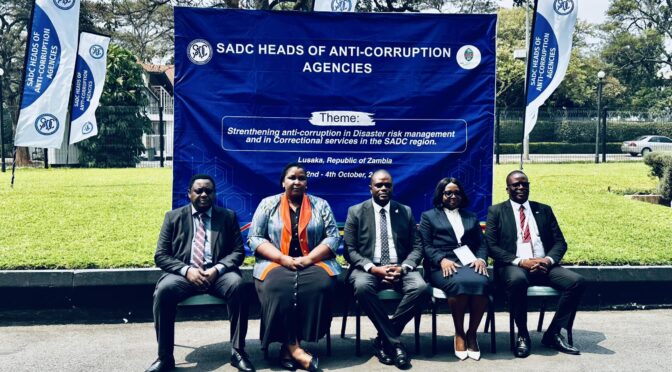By Ryan D. Martinson
While much of the international attention on China’s naval buildup is focused on its rapidly modernizing surface fleet, the People’s Liberation Army Navy (PLAN) is also taking bold steps to field a first-rate submarine force. By the end of this year, the service could have as many as 25 Yuan-class submarines, which are among the world’s most advanced diesel-electric boats. Its small-but-growing fleet of nuclear-powered attack (SSN), guided missile (SSGN), and ballistic missile (SSBN) submarines has achieved major technological upgrades, and with the benefit of a massive production facility in Huludao, may be on the cusp of significant expansion.
The PLAN is investing in submarines because it recognizes their tremendous potential deterrent and warfighting value. That value, however, hinges on the ability of their boats to operate undetected. According to Chinese military experts however, that basic requirement cannot be guaranteed—not even close. Writing in the November 2023 issue of Military Art (军事学术), a prestigious journal published by the Chinese Academy of Military Science, three PLAN officers revealed that the peacetime operations of Chinese submarines are highly vulnerable to the U.S. Navy’s undersea surveillance system, raising serious questions about their strategic and operational utility.
Entitled “Effectively Responding to the Threat to China’s Undersea Space Posed by the Powerful Enemy’s Three-Dimensional Surveillance System,” the article deserves special attention for two main reasons. First, while not an official assessment as might appear in a “white paper” or a “five-year plan,” it reflects the opinions of PLAN experts whose views are informed by access to classified intelligence and subject to peer review. The first author, Senior Captain Zhang Ning (张宁), is a faculty member at the Naval University of Engineering, College of Weapons Engineering. He co-authored the piece with Commander Zhang Tongjian (张同剑), from the 3rd Destroyer Flotilla (Unit 91257), and Lieutenant Fan Zhaopeng (范赵鹏) of the PLAN Oceanographic and Meteorological Center (Unit 91001). Second, the publication in which the article appears—Military Art—is an internal PLA journal (军内刊物). This enables the authors to share their expertise with a candor that is rarely (if ever) seen in publicly-available PLA sources.
The U.S. Undersea Surveillance System
The premise of the article is that in recent years the United States, AKA the “powerful enemy” (强敌), has employed an “integrated, three-dimensional surveillance system” (综合化立体监视体系) within and around the First Island Chain (i.e., China’s “Near Seas”). The system combines sensors and platforms located ashore, on and below the ocean, and in the air and space. In the undersea domain, the system comprises both fixed and mobile surveillance equipment, including unmanned underwater vehicles (UUVs) capable of carrying a range of payloads. On the surface of the ocean, the system incorporates U.S. Navy ships, especially ocean surveillance vessels. In the air, the system relies on fixed and rotary wing aircraft equipped with anti-submarine warfare (ASW) sensors. In space, it leverages ocean surveillance satellites, electronic reconnaissance satellites, and imaging reconnaissance satellites in near-earth orbit. The components, or “nodes,” of the system are connected via satellite communications and Raytheon’s real-time submarine communications system, “Deep Siren.”
Senior Captain Zhang and his co-authors argue that the U.S. undersea surveillance system constitutes both a strategic and tactical threat to China. First, it exerts what the authors call “strategic pressure” (战略压迫) on China’s undersea space. U.S. satellites can track Chinese submarines while in port, on the surface, and in shallow waters. U.S. Navy ships, operating together with undersea surveillance systems, can “aggressively monitor” (封锁监控) important PRC ports and straits, collecting data on the undersea environment and tracking submarine contacts. ASW aircraft operate in these areas too, often working collaboratively with surface vessels to “track and monitor” (跟踪监视) PRC submarines. U.S. undersea platforms such as submarines and UUVs also track and monitor PRC targets, while being capable of conducting strikes against them.
Second, the U.S. system can “cut off” (封断) Chinese submarines from access to important sea lanes, threatening their “navigational security” (航渡安全) while transiting to and from training and operating areas. According to the authors, in waters further away from China, the U.S. deploys fixed seabed sensors (海底固定声纳系统). Meanwhile, U.S. ocean surveillance vessels operate in the locations most conducive to underwater sound transmission, enabling them to achieve long-range detection of Chinese submarines. With all components of the undersea surveillance system working in concert, Sr. Capt. Zhang and his co-authors argue, “the probability that PRC submarines are discovered when leaving port is extremely high” (我潜艇出港即被发现的概率非常大), and “there is a fairly high probability that PRC submarines will be detected and intercepted while operating in the Near Seas” (我潜艇近海航渡被其发现拦截概率较大) [emphasis added]—a devastating indictment of the operational effectiveness of China’s submarine force.
Third, the authors write that the U.S. is “intensifying efforts” to achieve “unilateral transparency” (单向透明) of the undersea battlefield, to China’s great expense. The U.S. relies heavily on its hydrographic survey ships to track key characteristics of the water column (e.g., currents, temperature, salinity, and depth), thereby providing “powerful data support” for ASW operations. Meanwhile, U.S submarines closely track PLAN surface action groups to collect data on their acoustic signatures and “test” (检验) their defensive ASW capabilities. Lastly, the U.S. Navy’s undersea surveillance system poses a grave threat to China because it “undermines the country’s undersea nuclear deterrent” (削弱我海基核力量部署和威慑), presumably because the location of Chinese SSBNs cannot remain hidden. This, the authors argue, increases China’s vulnerability to sudden attack.
Potent, But Not Perfect
Sr. Capt. Zhang and his coauthors emphasize that while the U.S. system is highly effective, it is not without certain vulnerabilities. In fact, these weaknesses have grown increasingly apparent, in part due to “proactive” (积极主动) PRC measures. The U.S. system suffers from geographic constraints. The Near Seas are right on China’s doorstep, giving the PLAN a significant advantage. In recent years, they explain, it has become increasingly difficult for U.S. manned platforms to conduct reconnaissance close to the Chinese coast. Indeed, the “survival space” (生存空间) for U.S mobile and fixed unmanned systems within the First Island Chain has been shrinking. Additionally, the authors describe a “stalemate” (胶着状态) between China and the U.S. in the ability to “seal off” (封控) the three main straits between Taiwan and the Philippines (Bashi Channel, Balintang Channel, and Babuyan Channel). Within the First Island Chain, China has the advantage in terms of force disposition and the “battlefield situation” (战场态势), and “to a certain degree, it possesses the initiative” (在一定程度上占据对抗主动权).
The authors assert that the U.S. lacks sufficient forces to achieve its assumed objective of “unilateral transparency” at all times and in all places. The East China Sea and the South China Sea encompass vast areas with complex undersea environments, posing a particular challenge for U.S. surface and subsurface surveillance forces. Moreover, because the “battle lines” (战线) are so extended, the U.S. Navy simply lacks the necessary assets to cover it all. Air- and space-based platforms face their own problems with weather and limited detection range. The authors further argue that the location of individual “nodes” (体系节点) in the U.S. undersea surveillance system can be located and “removed” (清除). U.S bases and ships in rear areas suffer weak defensive capabilities; thus, as the authors write, they could be targeted at “key moments” (关键时刻难保周全), presumably at the start of a conflict. Air, surface, and subsurface nodes in waters near China are being “squeezed” (受到我对抗活动挤压) by Chinese forces, resulting in a reduction in the overall functionality of the system. In recent years, the authors point out, the U.S. Navy has had to step up investment in equipment and manpower in important straits and waters, which they describe as a costly and perhaps futile endeavor.
The U.S. undersea surveillance system relies on equipment and platforms which, while advanced, are not without limitations. For example, undersea cables and arrays are “fairly fragile and easily severed” (比较脆弱、易于割断). Electronic information equipment can be jammed or destroyed. Unmanned systems rely heavily on external support for repairs, maintenance, and command and control, while communications links are not necessarily dependable or resilient. The authors particularly highlight how the “core of the system,” i.e., the U.S. military’s command information network, “has a hard time coping with various kinds of soft kill and hard destruction measures” (软杀伤和硬摧毁手段). This, they argue, is the true “Achilles Heel” (死穴) of the U.S. undersea surveillance system.
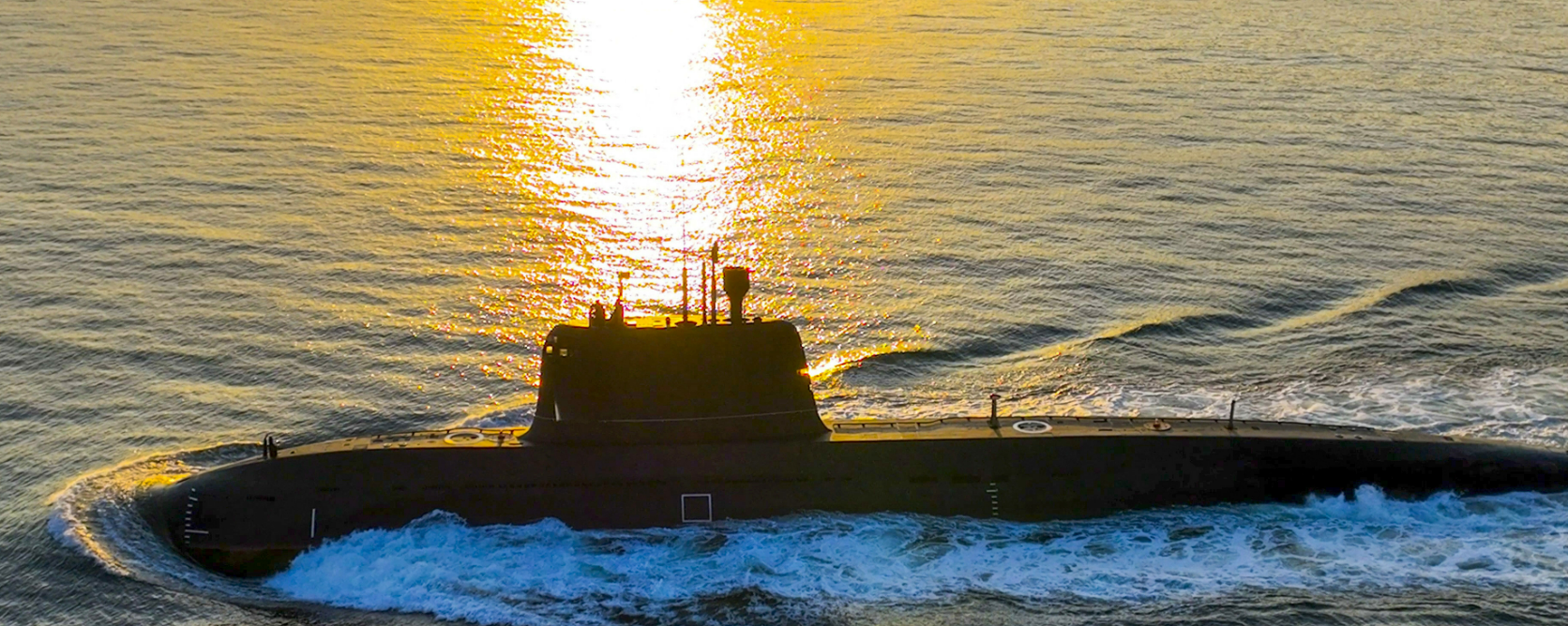
Targeting U.S. Vulnerabilities
After summarizing the main weaknesses of the U.S. system, Sr. Capt. Zhang and his co-authors then offer several recommendations for how best to exploit them. First, they argue, the goal of undersea security cannot be achieved overnight; it requires long-term planning. At the level of national strategy, China needs to combine both defensive measures and countermeasures, but it must place greater emphasis on countermeasures. That means prioritizing the development of capabilities needed to “attack and damage” (对抗并破坏) the U.S. undersea surveillance system. At what they call the “campaign level” (战役层面), China should strive to build an operational advantage within the region (区域作战优势). In particular, the authors highlight the need to “fully mobilize maritime militia and civilian fishing vessels” (充分发动海上民兵、地方渔船), without describing their specific roles in this endeavor. At the “tactical level,” China needs to develop new technologies, conduct reconnaissance against nodes in the U.S. Navy undersea surveillance network, and enhance the disposition and readiness of its undersea forces.
Second, the authors call for the PLAN to develop the technologies needed to counter the U.S. system. The first priority should be capabilities for “finding and fixing” (找得着、盯得住) key nodes, especially “small, quiet targets” (水下安静小目标), presumably referring to UUVs. They call for developing “detection arrays and reconnaissance and surveillance networks” that integrate acoustic, magnetic, optical, and electronic sensors. In their view, China also needs to incorporate artificial intelligence and data to support efforts to find (发现), identify (识别), evaluate (研判), and counter and destroy (防抗与毁伤) the components of the U.S. undersea surveillance system. To be successful, China will need to rely on support from civilian scientists and engineers, achieving “civil-military fusion” (军民融合).
Third, the PLAN must focus on training and readiness. Specifically, it should conduct training centered on “surveying, paralyzing, and destroying” (摸排、毁瘫、破击) U.S. equipment. Before that can happen, it needs to develop a clear understanding of the U.S. undersea surveillance system. The authors call for conducting surveys of shipping channels (开展航道测量) and “special reconnaissance missions” (专项侦察), and using side-scan sonar and high-frequency imaging sonar to perform detailed inspections of important straits, waterways, ports, and “suspicious ocean areas” (可疑海域)—presumably to locate hidden nodes in the U.S. system. Civilian and military specialists should complete studies of waters where U.S. ocean surveillance ships frequently operate to better grasp the types, numbers, and locations of the equipment they deploy.
The authors argue that the PLAN needs to conduct specialized training to better enable it to confront the U.S. undersea surveillance system. To that end, it must accelerate the acquisition of equipment and devices to destroy and disrupt enemy space-based, sea-based, and underwater surveillance nodes. In their view, China needs to develop UUVs that can locate enemy underwater arrays and interfere with and damage them. Regarding training practices, the authors argue that the PLAN should “use the enemy to train the troops” (拿敌练兵), a practice that favors simulated hostile engagements with actual foreign forces to hone China’s own warfighting skills.1
The authors highlight four specific approaches to reducing the effectiveness of the U.S. undersea surveillance system: yin (隐), bi (避), yan (掩), and rao (扰). Yin refers to using ocean environmental factors such as poor sea states, bad weather, thermoclines, and the Kuroshio (a warm water current east of Taiwan) for concealment of Chinese submarines. Bi refers to avoiding, where and when possible, enemy monitoring areas and methods. Yan refers to using undefined “supporting forces” (支援兵力) to actively “cover” (掩护) Chinese submarine operations and PLAN surface ships or merchant vessels to passively cover their operations. Rao means using deception or interference (诱骗干扰) or undefined “resolute measures” (果断措施) to degrade reconnaissance activities carried out by fixed and mobile, manned and unmanned, components of the U.S. system.
Fourth, China should, “depending on the situation, take action to precisely damage the [U.S.] network” (视情果断出击,精准破网). The authors argue, “at the key opportunity” (关键时机), China should aggress the enemy with undersea counter detection (水下反探测), anti-satellite weapons (航天反卫星), and methods to degrade electronic reconnaissance capabilities, damaging enemy networks and paralyzing enemy nodes. For example, in the case of U.S. fixed seabed arrays (海底固定探测阵), surface and subsurface buoys (潜浮标), seabed sonar (海底声呐), UUVs, and seabed prepositioned weapons (海底预置武器), the PLAN can use methods such as “deep-sea demolition” (深海爆破), “towing and damaging” (拖曳破捞), and “acoustic interference and deception” (声干扰和欺骗). The PLAN also needs UUVs that can both locate and attack enemy equipment. On the surface of the ocean, PLAN forces can approach U.S. ocean surveillance ships and deploy towed equipment or fishing nets to interfere with their operations. In the air, China can intercept and harass maritime patrol and reconnaissance aircraft, or “cut off’ (干扰阻断) information flows between aircraft and their sonobuoys, thereby “covering” the movements of China’s undersea forces. In the space domain, the PLAN should work with China’s strategic support forces to conduct strikes against or interfere with U.S. reconnaissance and communications satellites. In waters near enemy rear areas, China could deploy its own submarines, ASW aircraft, and ocean surveillance ships to conduct “proactive, multidimensional reconnaissance” (实施主动多维侦搜) to achieve what they call “forward deterrence” (对强敌形成前沿威慑). Lastly, against U.S. undersea operational command centers and information centers, China can conduct hard kills (硬杀伤) via “network cutoffs” (断网) and soft kills (软杀伤) using “black networks” (黑网).
Implications
The Chinese military is investing heavily in nuclear and conventional submarines because it recognizes their potential contributions in deterring China’s foes and, if necessary, defeating them in battle. However, if Sr. Capt. Zhang and his colleagues are correct, the PLAN cannot fully leverage the main advantage of submarines—their stealth. The authors argue that the operating and training areas of its submarine fleet are intensely monitored by components of the U.S. undersea surveillance system. Even when underway within the First Island Chain, they argue the probability is “fairly high” that their activities will be tracked and monitored by China’s most dangerous rival.
However, all is not lost. Sr. Capt. Zhang and his co-authors emphasize that the U.S. undersea surveillance system suffers from a number of vulnerabilities, amplified by the sheer scale of the Western Pacific battlespace. If enough nodes are degraded, the system as a whole may lose its functionality. The unmanned platforms upon which the system relies ultimately need human intervention for support and guidance, and that may not always be available when needed. Ultimately, however, the greatest vulnerability is the system’s dependence on the U.S. command information network, which allows for the integration of all the component parts. If that suffers degradation, then the whole system could fail. Still, as the authors imply in their article, the PLAN is not yet systematically exploiting these theoretical vulnerabilities. Meanwhile, PLAN submarines must continue to operate in this highly exposed environment.
Sr. Capt. Zhang and his colleagues offer a rare window into PLAN thinking on the undersea balance of power, and their analysis raises a number of intriguing questions. To what extent do their views reflect the full reality of U.S. capabilities? What are they missing? What do they get wrong? The answers to these questions—which can only be known by the quiet professionals who actually run the system—should inform key decisions about future U.S. naval operations within and beyond the First Island Chain.
The assessments of Zhang and his colleagues also provide important clues about future PLAN behavior, especially in the event of a military crisis. Because the PLAN is highly concerned about the survivability of its submarine fleet, it could be conservative in its employment in the run-up to hostilities, lest it risk needless losses in the opening phase of the war. This knowledge should allow U.S. analysts to more confidently gauge the significance of changes in PLAN operational patterns.
Their discussion about how to counter the U.S. undersea surveillance system provides fewer actionable insights. They are just recommendations, which of course may or may not be adopted. Still, that they are being discussed by serious experts means that the PLAN may be considering them. Thus, U.S. Navy leaders must also take them seriously. Nobody should be surprised if and when these technologies or tactics are employed against U.S. forces.
Ryan D. Martinson is an assistant professor in, and a core member of, the China Maritime Studies Institute at the Naval War College. He holds a master’s degree from the Fletcher School of Law and Diplomacy at Tufts University and studied at Fudan University, the Beijing Language and Culture University, and the Hopkins-Nanjing Center. He researches China’s maritime strategy, especially its coercive use of sea power in East Asia. In 2021, Martinson won the Naval War College’s Civilian Faculty Research Excellence Award.
The views expressed in this article reflect the personal opinions of the author alone and do not necessarily reflect the official views of the U.S. Department of the Navy, Department of Defense, or any other U.S. government entity.
The author thanks Dan Caldwell and Chris Sharman for their comments on an earlier draft of the article.
References
1. “Using the Enemy to Train the Troops—Beijing’s New Approach to Prepare its Navy for War,” by Ryan D. Martinson and Conor Kennedy, Jamestown Foundation, March 25, 2022.
Featured Image: A PLA Navy submarine attached to a submarine flotilla with the navy under the PLA Northern Theater Command steams to a designated sea area for training exercise in November 2023. (Photo by Zhang Nan/eng.chinamil.com.cn/)

